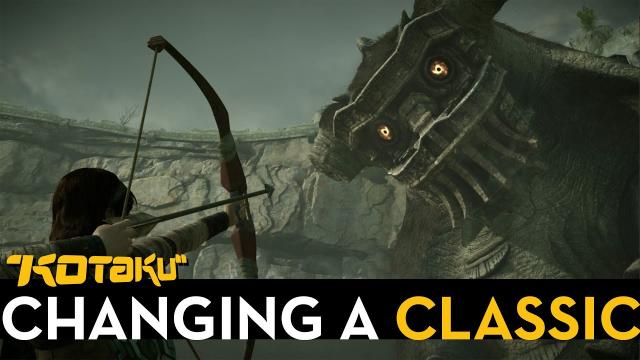The Shadow of the Colossus remake brings the PS2 classic to a new group of players, boosting up the graphics and changing the controls to make things a little less clumsy. For some those changes will improve the experience, but even small changes can have unexpected consequences.
Here’s a transcript if you can’t watch the above video:
The original Shadow of the Colossus released in 2005 for the PlayStation 2. The player travelled across barren wastes, hunting down giant monsters. The recent PlayStation 4 remake adds a fresh coat of paint, with lush foliage and softer lighting. It’s beautiful, but it changes the game world. While Shadow of the Colossus‘ world is now more lush and alive, the new version asks the question of what we lose when a remake change things.
Shadow of the Colossus tells the story of Wander, a young man on a quest to revive a dead woman named Mono. To achieve this, he makes a bargain with the god Dormin: Slay 16 massive colossi and Mono will be revived. The game is minimalist and focuses only on reaching each boss and fighting them. There are no NPCs to chat with or towns to visit. There are no dungeons to explore or treasure chests to find, although the new version has hidden coins to collect. There is nothing besides Wander, his loyal horse Agro, and the monsters he must slay. The lack of narrative details like excessive lore or branching dialog trees means that players must tell themselves the story, helped along by the game’s use of light and imagery.
One of the major visual quirks of the original version is a large amount of bloom lighting. Bright sunbeams blast into temples, and the forbidden lands that players explore are bathed in hard blueish glows. The powerful lighting communicates information about the world and creates a specific tone. For example, the opening of the game shows Wander riding under cover of darkness. Cloudy skies and rainy forests feel natural. When Wander enters the forbidden land, the harsh light cuts in. It feels unnatural, the powerful white-blue colour contrasting with the dreary skies that preceded it. There is a sense of power and wonder, a feeling that the world is coated by a magical glow. It tells the player that this space is different.
The remake opts for natural lighting that paints a different picture. The colours are warmer. Hint of yellow-red stream out onto a dusty desert, and the world feels slightly more grounded. This version of the forbidden lands is more muted. There is a sense that this was a space teeming with people that’s now been abandoned. It’s a feeling of loss and ruin that is less magical than the original. This version is still affecting, but there is a genuine change in the mood and tone.
Changing the lighting doesn’t just change the mood but also affects how players perceive characters. The stark contrast between light and dark in the PlayStation 2 version affects how players view Dormin. Dormin’s voice emanates down from a bright pool of light that feels like an extension of the hard, magical light that covers the world. There is a feeling that Dormin observes the entire world and slowly erodes it with holy light. In the remake, Dormin speaks from the light pool, but the more natural light doesn’t necessarily create a sense that they’re spread out beyond the central temple. This can affect our sense how powerful Dormin seems, potentially calling into question the nature of the bargain they make with Wander. When shadow figures crowd the temple after each colossus is slain, their presence might not hold the same impact due to the lack of visual contrast.
If the goal of Shadow of the Colossus‘ remake is to recreate the gameplay of the original, it succeeds. But whether or not it actually captures the feeling of the original game is another matter. Games are a collection of lighting, character models, music, animations, textures and action that create a complete package. Changing any one of these things fundamentally alters the composition of the work and transforms it into something different.
Apart from the graphical changes, there are quality of life improvements to the controls. Wander’s control in the original game were clumsy. Rolling required pushing R1 and triangle. In the remake, the default settings map this action to the circle button. Jumping meant pushing triangle, which has been moved to the much closer X button. Removing the extra physical actions means that the player doesn’t strain themselves as much and results in smoother movement. This can make Wander seem more competent than before, undercutting the power differential between him and the colossi. It’s a welcome change, but it influences how the game feels.
None of these changes are necessarily bad things but they are different. The remake’s world still has a strong weightiness to it. Its ruins feel just as storied at the original, and the colossi are still massive and imposing. Some people might find the new visuals and fixes help them enjoy Shadow of the Colossus more. But a game is more than gameplay, and when you change one thing, you change a whole lot more.

Leave a Reply